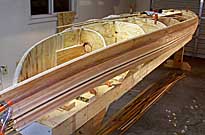
Sam Buchanan's Strip Canoe Project

Sam's Construction Log, page two
When you think of a strip canoe, the obvious component of the canoe is.......well, strips. Since the patterns are now on the strongback, it is time we convert several large cedar planks into a whole bunch of very small cedar planks. There are several sources for strips for a conoe project depending on type of wood desired and the construction budget. The conventional choice of hull material is white or western red cedar sawn into 1/4" x 3/4" strips, but canoe construction is not limited to those woods or size strips. Strip canoes have been constructed from many woods including various pines, basswood, and fir. I really like the look of western red cedar, so my choices included ripping the stock from lumber or purchasing the strips precut and shaped.
I want to explore the possibilities of constructing this canoe on a reasonable budget because......................I am cheap! While the easiest way to procure cedar strips is to buy them from a boat supply house, the less expensive alternative is to rip the strips from wood available locally. Some poking around local builder supply stores uncovered western red cedar boards in fairly short lengths and various quality, mostly with a lot of knots. This is lumber that is intended for use for housing trim or siding. The nominal thickness is about 3/4", usually with one side of the board still rough. Even though this is not prime material for our use, the price is much less than half what real canoe wood would cost. So the decision was made to bring home a stack of cedar boards and see if we could produce usable strips for the project. The longest board was only ten feet, but a few longer strips can be scarfed when necessary.
Here is what I purchased at a local Lowe's building supply store:
Four 1x8x10' @ $10.03 each
Nine 1x4x8' @ $4.30 each
Three 1x6x10' tongue and groove @ $9.59 each
Three 1x2x8' clear white pine @ $3.64 each
The clear white pine is for accent stripes. The tongue and groove siding was purchased because it was amazingly clear and straight-grained. The other boards had minimal knots and resulted from extensive picking through the display in the store. We can't figure true board feet because the lumber is less than one inch thick, but a rough estimate put the total stack at about 68 "effective" board feet. The actual board foot number is less than this, but maybe this will help compare numbers. The cost figured out to less than $2.00 per "effective" board foot. Real canoe cedar lumber usually costs over $4.00 per board foot, plus expensive shipping, especially if long boards are ordered.
Since the lumber was rough on one side, we needed to run the wood through a planer. It is very helpful to have access to nice equipment, and since I have conned, er, convinced master woodworker Wayne Kuykendall to also build a canoe, a shopfull of wonderful equipment is closeby.
(3/17/00; planed and ripped cedar strip)

Fellow conspirator (and son) Michael and I first ran the boards through the planer which resulted in planks with a thickness of slightly over 5/8".
"But....but, the books say to use strips that are 3/4" or 7/8" wide", you might implore.
Yes, but the narrower strips play nicely into our scheme to forego bead and cove shaping since the narrow strips will be easier to form over the bilge area of the canoe. And, since more inexpensive wood is just a short drive away, there is no shipping expense for another plank or so in the future if necessary.

The fence on the table saw was set for 1/4", a narrow blade installed, and the sawdust flew for an hour and a half as the stack of cedar boards was reduced to a bundle of little sticks.

Notice the push stick in the photo above and in use in this photo that is essential for keeping valuable fingers clear of the blade as the planks are ripped. Cedar dust can be an irritant to lungs, so dust masks and safety glasses are the order of the day.
I wish I could have found more of the clear tongue and groove boards because they resulted in some really beautiful strips. By the way, each tongue and groove board yielded 12 strips. I found a couple of dark reddish-brown boards that will complement the white pine and give a nice accent detail.

Here is the result of the ripping session. The overall quality of the strips is very good, and even though many builders would prefer to use longer strips, these strips will work very nicely, especially since we now have an extra couple of hundred dollars in our pocket to spend on fiberglass supplies!
(3/19/00; getting ready to strip!)

The stem patterns are planed to a sharp radius so the strips will lay snugly against the pattern.

Masking tape is applied to the patterns so we won't glue the strips to the patterns.
Forward to Sam's construction log, page three